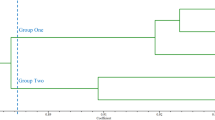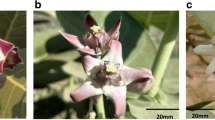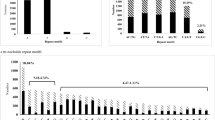Abstract
Jatropha curcas (jatropha) is a multipurpose plant with potential as a raw material for biofuel. In the present study, a total of 43,349 expressed sequence tags (ESTs) from J. curcas were searched for type and frequency of simple sequence repeat (SSR) markers. Five thousand one hundred and seventy-five sequences were indentified to contain 6,108 SSRs with 90.8% simple and 9.2% compound repeat motifs. One hundred and sixty-three EST-SSRs were developed and used to evaluate the transferability and genetic relatedness among 4 accessions of J. curcas from China, Mexico, Thailand and Vietnam; 5 accessions of congeneric species, viz. J. gossypiifolia, dwarf J. integerrima, normal J. integerrima, J. multifida, J. podagrica; and Ricinus communis. The polymorphic markers showed 75.56–85.19% transferability among four species of Jatropha and 26.67% transferability across genera in Ricinus communis. Investigation of genetic relatedness showed that J. curcas and J. integerrima are closely related. EST-SSRs used in this study demonstrate a high efficiency of cross species/genera amplification and are useful for identifying genetic diversity of jatropha and its close taxa and to choose the desired related species for wide crossing to improve new varieties of jatropha. The markers can also be further exploited for genetic resource management and genetic improvement of related species/genera through marker-assisted breeding programs.
Similar content being viewed by others
Abbreviations
- EST:
-
expressed sequence tag
- ISSR:
-
intersimple sequence repeat
- SSR:
-
simple sequence repeat
- UPGMA:
-
unweighted pair group method with arithmetic average
References
Basha S.D., Francis G., Makkar H.P.S., Becker K. & Sujatha M. 2009. A comparative study of biochemical traits and molecular markers for assessment of genetic relationships between Jatropha curcas L. germplasm from different countries. Plant Sci. 176: 812–823.
Basha S.D. & Sujatha M. 2009. Genetic analysis of Jatropha species and interspecific hybrids of Jatropha curcas using nuclear and organelle specific markers. Euphytica 168: 197–214.
Berchmans H.J. & Hirata S. 2008. Biodiesel production from crude Jatropha curcas L. seed oil with a high content of free fatty acids. Bioresour. Technol. 99: 1716–1721.
Carvalho C.R., Clarindo W.R., Prac M.M., Araujo F.S. & Carels N. 2008. Genome size, base composition and karyotype of Jatropha curcas L.: an important biofuel plant. Plant Sci. 174: 613–617.
Ganesh R.S., Parthiban K.T., Kumar R.S., Thiruvengadam V. & Paramathma M. 2008. Genetic diversity among Jatropha species as revealed by RAPD markers. Genet. Resour. Crop Evol. 55: 803–809.
Gao L.Z., Zhang C.H. & Jia J.Z. 2005. Cross-species transferability of rice microsatellites in its wild relatives and the potential for conservation genetic studies. Genet. Resour. Crop Evol. 52: 931–940.
Johnson T.S., Eswaran N. & Sujatha M. 2011. Molecular approaches to improvement of Jatropha curcas Linn. as a sustainable energy crop. Pant Cell Rep. 30: 1573–1591.
Kumpatla S.P. & Mukhopadhyay S. 2005. Mining and survey of sample sequence repeats in expressed sequence tags of dicotyledonous species. Genome 48: 985–998.
Na-ek Y., Wongkaew A., Phumichai T., Kongsiri N., Kaveeta R., Sreewongchai T. & Phumichai C. 2011. Genetic diversity of Physic nut (Jatropha curcas L.) revealed by SSR markers. J. Crop Sci. Biotech. 14: 105–110.
Pamidimarri D.V.N.S., Pandya N., Reddy M.P. & Radhakrishnan T. 2009. Comparative study of interspecific genetic divergence and phylogenic analysis of genus Jatropha by RAPD and AFLP. Mol. Biol. Rep. 36: 901–907.
Pamidimarri D.V.N.S., Mastan S.G., Rahman H., Prakash C.R., Singh S. & Reddy M.P. 2011. Cross species amplification ability of novel microsatellites isolated from Jatropha curcas and genetic relationship with sister taxa. Mol. Biol. Rep. 38: 1383–1388.
Parawira W. 2010. Biodiesel production from Jatropha curcas: a review. Sci. Res. Essays 5: 1796–1808.
Phumichai C., Phumichai T., Kongsiri N., Wongkaew A., Sripichit P. & Kaveeta R. 2011. Isolation of 55 microsatellite markers for Jatropha curcas and its closely related species. Biologia Plant. 55: 387–390.
Rohlf F.I. 2009. NTSYSpc: Numerical Taxonomy and Multivariate Analysis System, Version 2.2 Exeter Software. Setauket, New York.
Senthil K.R., Parthiban K.T. & Govinda R.M. 2009. Molecular characterization of Jatropha genetic resources through intersimple sequence repeat (ISSR) markers. Mol. Biol. Rep. 36: 1951–1956.
Sneath P.H.A. & Sokal R.R. 1973. Numerical Taxonomy: The Principles and Practice of Numerical Classification. Freeman, San Francisco.
Sokal R.R. & Rohlf J. 1994. Biometry: The Principles and Practice of Statistics in Biological Research. Freeman, New York.
Sun Q.B., Li L.F., Li Y., Wu G.J. & Ge X.J. 2008. SSR and AFLP markers reveal low genetic diversity in the biofuel plant Jatropha curcas in China. Crop Sci. 48: 1865–1871.
Tanya P., Dachapak S., Tar M.M. & Srinives P. 2011a. New microsatellite markers classifying nontoxic and toxic Jatropha curcas. J. Genet. 90: e76–e78.
Tanya P., Taeprayoon P., Hadkam Y. & Srinives P. 2011b. Genetic diversity among Jatropha and Jatropha-related species base on ISSR markers. Plant Mol. Biol. Rep. 29: 252–264.
Varshney R.K., Graner A. & Sorrells M.E. 2005. Genetic microsatellite markers: features and applications. Trends Biotechnol. 23: 48–55.
Wen M., Wang H., Xia Z., Zou M., Lu C. & Wang W. 2010. Development of EST-SSR and genomic-SSR markers to assess genetic diversity in Jatropha curcas L. BMC Res. Notes 3: 42.
Yab V. & Nelson R.J. 1996. Winboot: A Program for Performing Bootstrap Analysis of Binary Data to Determine the Confidence Limits of UPGMA-Based Dendrograms. IRRI, Philippines.
Yadav H.K., Ranjan A., Asif M.H., Mantri S., Sawant S.V. & Tuli R. 2011. EST-derived SSR markers in Jatropha curcas L.: development, characterization, polymorphism, and transferability across the species/genera. Tree Genetics Genomes 7: 207–219.
Author information
Authors and Affiliations
Corresponding author
Rights and permissions
About this article
Cite this article
Laosatit, K., Tanya, P., Saensuk, C. et al. Development and characterization of EST-SSR markers from Jatropha curcas EST database and their transferability across jatropha-related species/genus. Biologia 68, 41–47 (2013). https://doi.org/10.2478/s11756-012-0143-5
Received:
Accepted:
Published:
Issue Date:
DOI: https://doi.org/10.2478/s11756-012-0143-5




